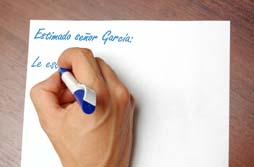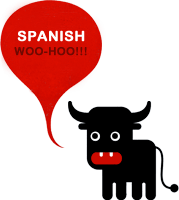Spanish Formal Writing

There are numerous ways in Spanish to ensure the formality of a written piece of correspondence, many of which are based on the layout and style of the letter. It should contain the address of the sender in the top right corner followed by telephone number and email address if possible. The recipient address is positioned below this and to the left above the letter introduction.
To introduce the letter, there are a number of formal options:
Estimado señor o señora + surname
Muy señor mío/ Muy señora mía + full name
Distinguido señor + surname
If writing to someone that you know well or who is a friend, the following option would be more suitable: Querido + name
Depending on the nature and subject of the letter, content may be of a particular formality or tone which can effect the way in which the language is presented and how the letter will be closed.
Here are some general closing statements that can be used in any circumstance of formal letter writing:
A la espera de sus prontas noticias, (Awaiting your response,)
Sin otro particular, le saluda atentamente, (With no further addition, best regards,)
or just, Le saluda atentamente (Best regards)
For less formal letters, these endings are more appropriate:
Un saludo (Best wishes)
Un abrazo (A hug)
Besos (Kisses)
Spanish Postal System
The Spanish postal system is not unlike that in the UK, nor in France, basically meaning that if there’s a queue, you’re definitely in the right place. Spain’s post service is commonly known as Correos and offices can be found across the city as well as within larger department stores and chains of El Corte Inglés.

Working as any postal service does, queues are highly likely and it’s surprising long each customer can spend at the desk. This is because not only do people visit the post office to send parcels and letters, but also to collect official forms, pick-up parcels that have been delivered there, send faxes etc. If you need stamps, then avoid the queues by buying them from any tobacconists and then posting your letter in a yellow post box, which can be found everywhere. You can spot the tobacconists (or estanco) by the large yellow T displayed outside.
Addresses are written differently in Spain compared to other countries and follow this kind of layout:
Recipient Name
Street type, street name, building number
Post code, town/city
Country

Email is becoming an increasingly common form of communication in Spain, especially within businesses and amongst friends. Working in an office, it is more likely for a colleague to email you about something rather than physically walk over to you and explain in person. Due to its popularity, email etiquette is key in ensuring the appropriate level of discourse and etiquette during correspondence.
A formal email should begin with Estimado (dear) followed by the name of the recipient including their title. To end, En espera de su respuesta (Awaiting your reply…) or Muy agradecidos por la atención… (Many thanks for taking the time…) are suitable ways to draw the email to a close.
For informal correspondence, between colleagues for example, chatty language is much more appropriate especially because topics are usually centred on current issues and developments. Beginning an email with ‘Hola’ or simply the recipients name is appropriate followed by the content. To finish, an email should end with ‘saludos’ meaning ‘regards’.









